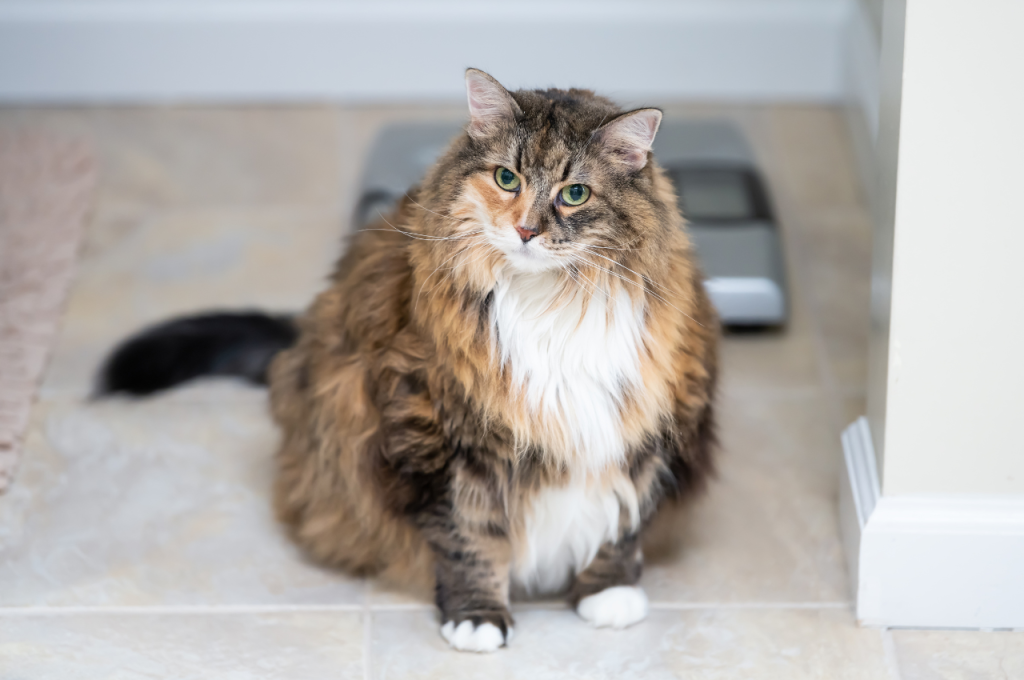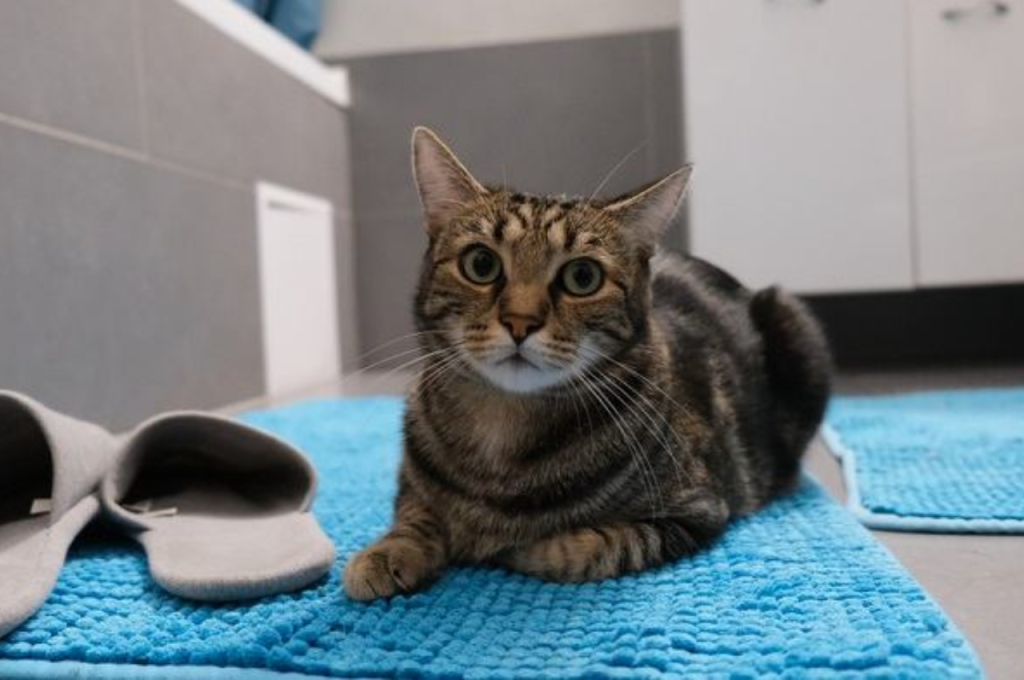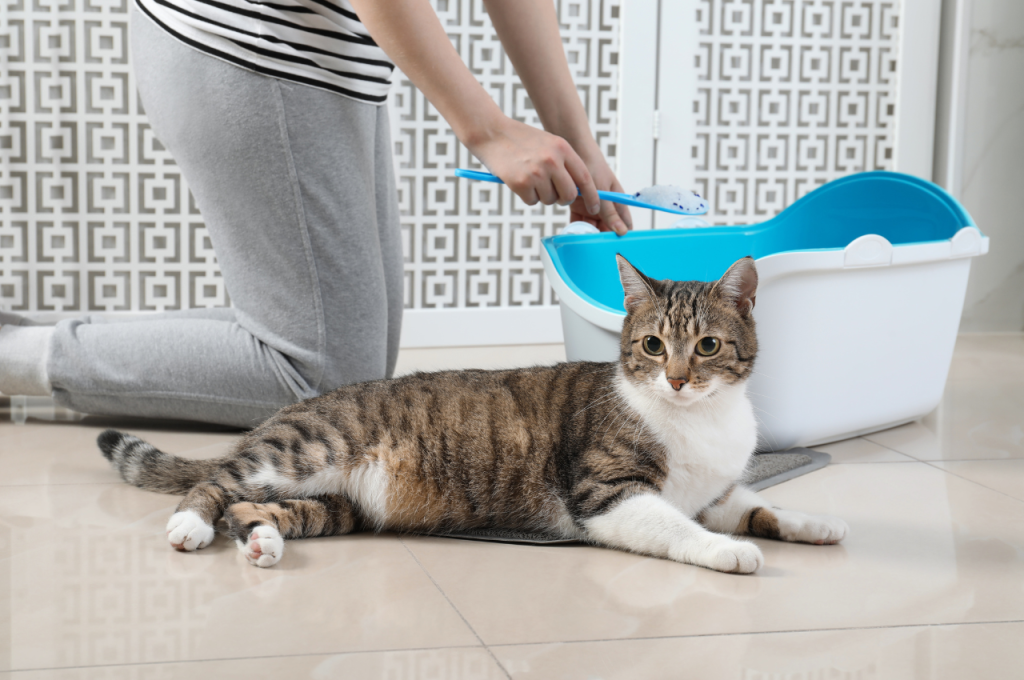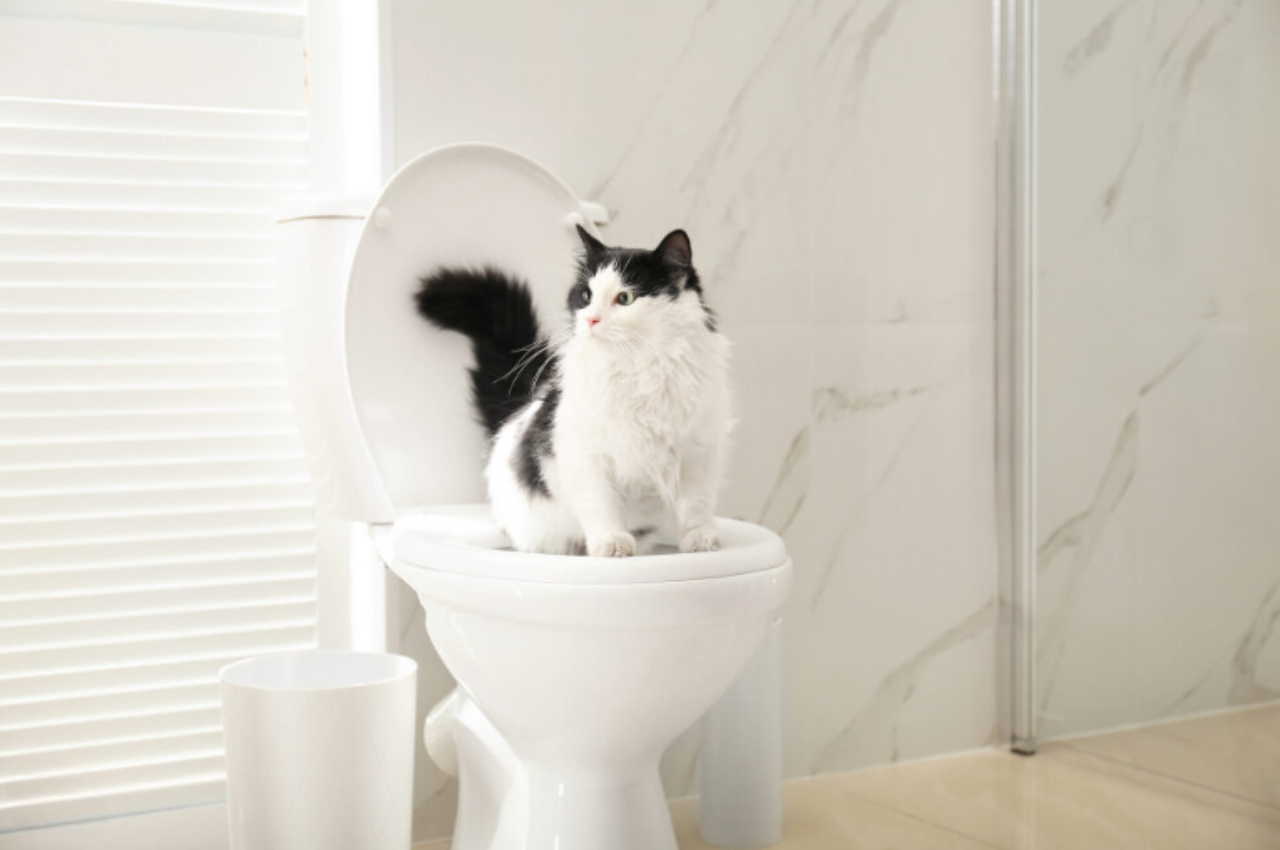Cats may pee on bathroom floors due to various reasons, such as urinary tract issues or territory marking. Introducing: Cat Peeing on Bathroom Floor Discovering cat pee on your bathroom floor can be frustrating.
It’s important to address this issue promptly to maintain a clean and odor-free environment. Cats may urinate outside their litter box for several reasons. One possibility is a urinary tract issue, which could be caused by a urinary tract infection, bladder stones, or other medical conditions.
Another reason could be territory marking, especially if you have multiple cats in your household. Understanding the underlying cause is crucial in finding the appropriate solution. We will explore the potential reasons behind this behavior and provide practical tips to help solve the problem. Let’s dive in and find out how to tackle the issue of cat peeing on the bathroom floor.
Understanding the Problem
Understanding the problem of a cat peeing on the bathroom floor is essential for cat owners to address this issue effectively. It can be frustrating and concerning for many reasons. In this section, we will explore the possible reasons for cat peeing, the impact it can have on both the household and the cat’s health.

Possible Reasons for Cat Peeing
There are several factors that may contribute to a cat’s behavior of urinating on the bathroom floor. Understanding these reasons can help us tackle the problem at its root. Here are some possible explanations for this behavior:
- Litter Box Issues: A dirty or inaccessible litter box can cause a cat to seek alternative places to relieve itself.
- Medical Problems: Cats may urinate outside the litter box if they have urinary tract infections, bladder stones, or other health issues that cause discomfort.
- Anxiety or Stress: Changes in the household, such as moving to a new home, introducing a new pet, or disruptions in routine, can make cats feel anxious or stressed, leading to inappropriate urination.
- Territorial Marking: Some cats may mark their territory by urinating outside the litter box, especially if they perceive a threat or feel the need to assert dominance.
Impact on Household and Cat’s Health
Having a cat pee on the bathroom floor can cause several issues for both the household and the cat’s well-being. It’s important to address this behavior promptly to maintain a clean and healthy living environment while ensuring the cat’s happiness. Here are some potential consequences:
- Unpleasant Odor: The strong smell of cat urine can be persistent and difficult to eliminate, negatively impacting the atmosphere within the home.
- Damage to Flooring: Continuous urination on the bathroom floor can damage the flooring material, leading to costly repairs or replacements.
- Spread of Bacteria: Cat urine carries bacteria that can pose health risks to both humans and other pets, increasing the chances of infections.
- Stress for the Cat: Cats naturally prefer clean environments and may experience stress or discomfort if they repeatedly choose to urinate outside the litter box.
In order to address the problem of a cat peeing on the bathroom floor effectively, it is crucial to understand the possible reasons behind this behavior and recognize the impact it can have on both the household and the cat’s health. By addressing any underlying issues and implementing appropriate solutions, we can create a harmonious environment that satisfies both the cat’s needs and the household’s cleanliness.
Creating A Pet-friendly Bathroom Environment
Keep your bathroom pet-friendly by choosing non-absorbent flooring and regularly cleaning the area. Consider setting up a designated litter box for your cat and invest in odor-neutralizing products. Also, make sure to keep any personal care items out of reach to prevent unwanted accidents.
Bathrooms are important spaces for both humans and pets. To prevent your cat from peeing on the bathroom floor, it’s crucial to create a pet-friendly environment that caters to their needs. By focusing on key aspects like the litter box, you can effectively manage your cat’s behavior and maintain a clean and hygienic bathroom.
Choosing the Right Litter Box
When selecting a litter box for your cat, opt for one that is spacious enough for them to move around comfortably. Ensure the litter box has low sides for easy entry and exit. Consider a covered litter box for privacy and odor control.
Placing the Litter Box in the Right Spot
Position the litter box in a quiet and accessible location in the bathroom. Avoid placing it near loud appliances or in high-traffic areas. Ensure the litter box is easily visible and within reach for your cat.
Behavioral Modification Techniques
To address a cat peeing on the bathroom floor, implementing behavioral modification techniques can be effective. This may involve providing a designated area for elimination, using deterrents, and increasing environmental enrichment. Consistency and positive reinforcement are key in modifying the cat’s behavior.
Cat pee on the bathroom floor is not only unpleasant, but it can also be a sign of an underlying behavioral issue. To address this problem, there are effective behavioral modification techniques that you can try. By understanding the root cause of your cat’s behavior and implementing these techniques, you can help your furry friend develop better bathroom habits.
Positive Reinforcement
Positive reinforcement is a powerful tool in modifying your cat’s behavior. By rewarding good behavior, you can encourage your cat to develop the desired habits. When your cat uses the litter box instead of the bathroom floor, make sure to praise and reward them with a treat or a gentle pat on the head. This positive association will reinforce the desired behavior and increase the likelihood of your cat using the litter box consistently.
If you notice your cat starting to pee on the bathroom floor, try redirecting them to the litter box immediately. Gently pick them up and place them in the litter box, using a calm and soothing tone to encourage them.
Discouraging Undesired Behavior
To deter your cat from peeing on the bathroom floor, it’s important to discourage undesired behavior. There are several techniques you can use to discourage this behavior and redirect your cat’s attention.
- Clean the affected area: Thoroughly clean the bathroom floor using an enzyme-based cleaner specifically designed to neutralize the smell of cat urine. Cats are more likely to repeat the behavior if they can still detect the scent.
- Provide multiple litter boxes: Ensure that you have multiple litter boxes available in convenient locations throughout your home. Cats prefer to have options, and having multiple litter boxes can reduce the chances of peeing on the bathroom floor.
- Ensure litter box cleanliness: Cats are clean animals and prefer a clean litter box. Regularly scoop and clean the litter box to provide a pleasant environment for your cat to do their business.
- Use deterrents: Place physical deterrents such as aluminum foil or double-sided tape on the bathroom floor. Cats dislike the texture and will be less likely to use it as a pee spot.
Remember, consistency is key when implementing these behavioral modification techniques. Be patient with your cat as it may take time for them to adjust to the changes. With persistence and positive reinforcement, you can help your cat break the habit of peeing on the bathroom floor and promote healthier bathroom behaviors.
Medical Interventions
When cats exhibit inappropriate bathroom behavior, such as peeing on the floor, it’s crucial to consider medical interventions to address potential underlying health issues.

Consulting A Veterinarian
Consulting a veterinarian is the first step in addressing your cat’s peeing problem. A professional can provide insights into potential health issues and treatment options.
Identifying Potential Health Issues
- Focus on identifying potential health issues that may prompt your cat to urinate outside the litter box. Common issues include urinary tract infections and bladder stones.
- Observing your cat’s behavior and any accompanying symptoms can help pinpoint the underlying health concern.
- A thorough physical examination by a vet can reveal any health issues that need to be addressed to prevent further incidents of inappropriate urination.
Cleaning and Neutralizing Odors
Dealing with the challenge of a cat peeing on the bathroom floor can be frustrating. The lingering odor can be particularly difficult to eliminate if not addressed promptly and effectively. In this section, we will discuss proven methods for cleaning and neutralizing odors caused by cat urine.
Effective Cleaning Products
When it comes to tackling cat urine odors on bathroom floors, using the right cleaning products is crucial. Look for enzymatic cleaners specifically designed to break down urea and uric acid, the components of cat urine that cause strong odors. These cleaners are highly effective in eliminating the smell at the source, rather than just masking it.
Natural Remedies for Odor Removal
If you prefer natural remedies, there are several options for neutralizing cat urine odors in the bathroom. White vinegar and baking soda are known for their odor-absorbing properties. Create a solution using equal parts of water and white vinegar, and then sprinkle baking soda over the affected area. Let it sit for a few hours before thoroughly rinsing and drying the spot.
Preventive Measures
Preventive measures play a crucial role in addressing the issue of cat peeing on the bathroom floor. By implementing certain strategies, cat owners can effectively minimize the likelihood of this behavior, promoting a clean and harmonious living environment for both humans and felines.
Routine Veterinary Check-ups
Regular veterinary check-ups are essential in maintaining the overall health and well-being of your cat. Through these check-ups, ailments or health issues can be identified and addressed promptly, potentially reducing the likelihood of stress-induced marking behavior such as inappropriate urination. Ensure that your cat’s vaccinations are up to date and discuss any behavioral concerns with your veterinarian during these visits.
Environmental Enrichment for Cats
Cats thrive in enriched environments that cater to their natural instincts and behaviors. Providing enrichment through interactive toys, scratching posts, and cat trees can help alleviate boredom and stress, leading to a reduced likelihood of inappropriate marking behaviors. Additionally, creating vertical spaces for your cat to climb and observe their surroundings can contribute to their overall mental and physical well-being.
Monitoring Progress
Monitoring your cat’s progress when dealing with inappropriate peeing on the bathroom floor is crucial in order to determine if the behavior is improving or not. It allows you to track behavior changes and recognize signs of improvement, enabling you to take the necessary steps for resolving the issue. By closely monitoring the situation, you can ensure that your efforts are working effectively and adjust your approach if needed. Here are some key aspects to consider when monitoring your cat’s progress:
Tracking Behavior Changes
One of the first steps in monitoring your cat’s progress is to track any behavior changes related to their inappropriate peeing. Keep a record of when and where your cat urinates outside the litter box, as well as any triggers or changes in their environment. This information can help you identify patterns and potential causes for the behavior.
Additionally, observe if your cat is showing any signs of stress or anxiety, such as excessive grooming, hiding, or aggression. These behaviors can be indicators that the underlying issue is still present and may require further attention.
Recognizing Improvement Signs
As you continue to address the issue of your cat peeing on the bathroom floor, it’s essential to be vigilant in recognizing signs of improvement. Look out for positive changes in their behavior, such as consistently using the litter box, displaying relaxed body language, and engaging in playful activities. If your cat starts exploring the bathroom without exhibiting peeing behavior, this can be a positive indicator that your efforts are working. Keep track of these improvements to assess whether your cat’s behavior is gradually improving over time.
Seeking Professional Help if Necessary
Seeking professional help from an expert might be necessary if your cat keeps peeing on the bathroom floor. Engaging a Professional Animal Behaviorist or considering Cat Training Programs can help address this issue effectively.
Engaging A Professional Animal Behaviorist
Professional Animal Behaviorists are specialists in understanding and modifying animal behavior. They can evaluate your cat’s behavior, identify the root cause, and recommend tailored solutions to stop inappropriate peeing habits.

Considering Cat Training Programs
Cat Training Programs offer structured approaches to modify your cat’s behavior. With methods like positive reinforcement and environmental enrichment, these programs can gradually train your cat to use the litter box appropriately.
Frequently Asked Questions on Cat Peeing on Bathroom Floor
How do I stop my cat from peeing in the bathroom floor? Do I Stop My Cat From Peeing On The Bathroom Floor?
To stop your cat from peeing on the bathroom floor, clean the area thoroughly. Provide more litter boxes, scoop them daily, and use a litter attractant. Ensure your cat has regular vet check-ups and consider behavioral modification techniques, such as positive reinforcement.
Why Does My Cat Keep Peeing In The Bathroom?
Your cat may be peeing in the bathroom due to territorial marking or a urinary tract issue. Ensure a clean litter box, regular vet check-ups, and a calm environment to address the behavior.
Why Would A Cat Suddenly Pee On The Floor?
Sudden floor peeing in cats can indicate medical issues like UTI, stress, or territorial behavior. Consult a vet to rule out health concerns and address any environmental triggers.
Why Is My Cat Peeing On Bathroom Rug?
Your cat may be peeing on the bathroom rug due to reasons like urinary tract infection, behavioral issues, or stress. Provide a clean litter box, ensure medical checkup, and minimize stress to address this problem.
Conclusion
Dealing with a cat peeing on the bathroom floor can be frustrating, but there are steps you can take to resolve the issue. By understanding the possible causes, implementing proper litter box hygiene, and providing enough resources for your cat, you can effectively prevent this behavior.
Remember, patience and consistency are key when it comes to resolving any cat-related problem. With a little effort and attention, you can effectively solve the problem of a cat peeing on the bathroom floor and maintain a clean and pleasant home environment.
